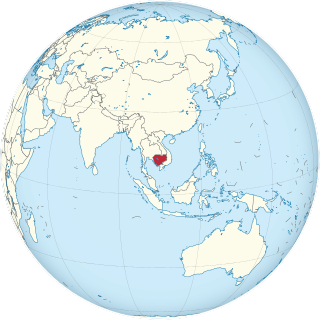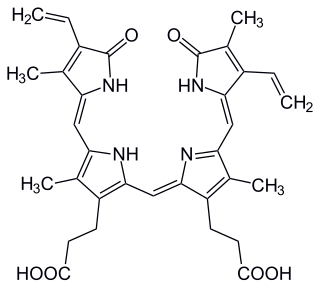
Cambodia is a country in mainland Southeast Asia, bordering Thailand, Laos, Vietnam, the Gulf of Thailand and covers a total area of 181,035 km2 (69,898 sq mi). The country is situated in its entirety inside the tropical Indomalayan realm and the Indochina Time zone (ICT).

The Dâmrei Mountains, refer to a mountain range situated in south-western Cambodia, traversing around 110 km (68 mi) north-south as a succession of the Cardamom Mountains, dropping abruptly to the sea near the town of Kampot. The Elephant Mountains represent the easternmost parts of the original extent of the wet evergreen forests that include Cambodia's south and the mountains east of Bangkok in Thailand.

Biliverdin is a green tetrapyrrolic bile pigment, and is a product of heme catabolism. It is the pigment responsible for a greenish color sometimes seen in bruises.

The Cardamom Mountains, or Krâvanh Mountains, is a mountain range in the south west of Cambodia and Eastern Thailand. The majority of the range is within Cambodia.

Oligodon is genus of colubrid snakes that was first described by the Austrian zoologist Fitzinger in 1826. This genus is widespread throughout central and tropical Asia.
Megophrys auralensis is a species of frog in the family Megophryidae. It is endemic to Cambodia where it is only known from Phnom Aural, the highest mountain of Cambodia. Its type locality is within the Phnom Aural Wildlife Sanctuary. Its natural habitats are tropical moist lowland forests, moist montane forests, and rivers.

Limnonectes gyldenstolpei is a species of frog in the family Dicroglossidae. It is found in northern Thailand, Laos, and southwestern Cambodia.
Philautus cardamonus is a species of frogs in the family Rhacophoridae.

Wildlife Alliance is an international non-profit wildlife and forest conservation organization with current programs and partnerships in Cambodia. It is headquartered in New York City, with offices in Phnom Penh. The logo of the organization is the Asian elephant, an emblematic species of Southeast Asia and the namesake for the organization's programs in the Southwest Elephant Corridor of the Cardamom Mountains of Cambodia. Suwanna Gauntlett is the Founder and CEO of Wildlife Alliance and one of the original founders of WildAid. The organization is governed by a Board of Directors, and a International Advisory Board provides guidance on strategy, fundraising, and outreach.

Botum Sakor National Park is the largest national park of Cambodia. Situated on the coast of the Gulf of Thailand, Botum Sakor is a peninsula projecting southwest from the Cardamom Mountains. The national park comprises an area of 1,825.85 km2 (704.96 sq mi) and spans three districts of Koh Kong Province: Kiri Sakor, Botum Sakor and Koh Kong. The park is under the administration of the Cambodian Ministry of Environment.

Phnom Samkos Wildlife Sanctuary is a wildlife sanctuary in western Cambodia, bordering Thailand. The sanctuary was established in 1994 and covers 3,307.56 km2 (1,277.06 sq mi). It is also designated as an Important Bird Area (IBA).

Callenya lenya, the long-winged hedge blue, is a butterfly of the family Lycaenidae.

The Cardamom Mountains rain forests is a tropical moist broadleaf forest ecoregion in Southeast Asia, as identified by the WWF. The ecoregion covers the Cardamom Mountains and Elephant Mountains and the adjacent coastal lowlands in southeastern Thailand and southwestern Cambodia, as well as the Vietnamese island of Dao Phu Quoc.

The Central Cardamom Mountains is a protected forest in the central parts of Cambodia's Cardamom Mountains, covering 4,010.65 km2 (1,548.52 sq mi). It was established in 1999 and spans three provinces. The Central Cardamom Mountains is flanked east and west by Phnom Aural Wildlife Sanctuary and Phnom Samkos Wildlife Sanctuary respectively.
Lycodon zoosvictoriae is a species of wolf snake. It was discovered in Cambodia in June 2014.
Lycodon cardamomensis, also known as the Cardamom Mountains wolf snake, is a species of non-venomous colubrid snakes found in south-western Cambodia and south-eastern Thailand.
Oligodon moricei, commonly known as Morice's kukri snake, is a species of snake in the family Colubridae. The species is endemic to southern Vietnam.

Oligodon deuvei is a species of snake in the family Colubridae. The species is endemic to Southeast Asia.
Oligodon pseudotaeniatus, commonly known as the false striped kukri snake, is a species of colubrid snake. It is endemic to Thailand and known from the Nakhon Ratchasima Province, Saraburi Province, and Bangkok. The type series was collected by Malcolm Arthur Smith. The specific name pseudotaeniatus refers to its similarity to Oligodon taeniatus, with whom it was confused prior to its species description in 2008.

Southern Cardamom National Park is a national park in Cambodia. The protection was established on 9 May 2016 and covers 4,104 km2 (1,585 sq mi) in the southern parts of the Cardamom Mountains. The national park is administratively divided into three sectors; Western Sector, Central Sector and Eastern Sector.












